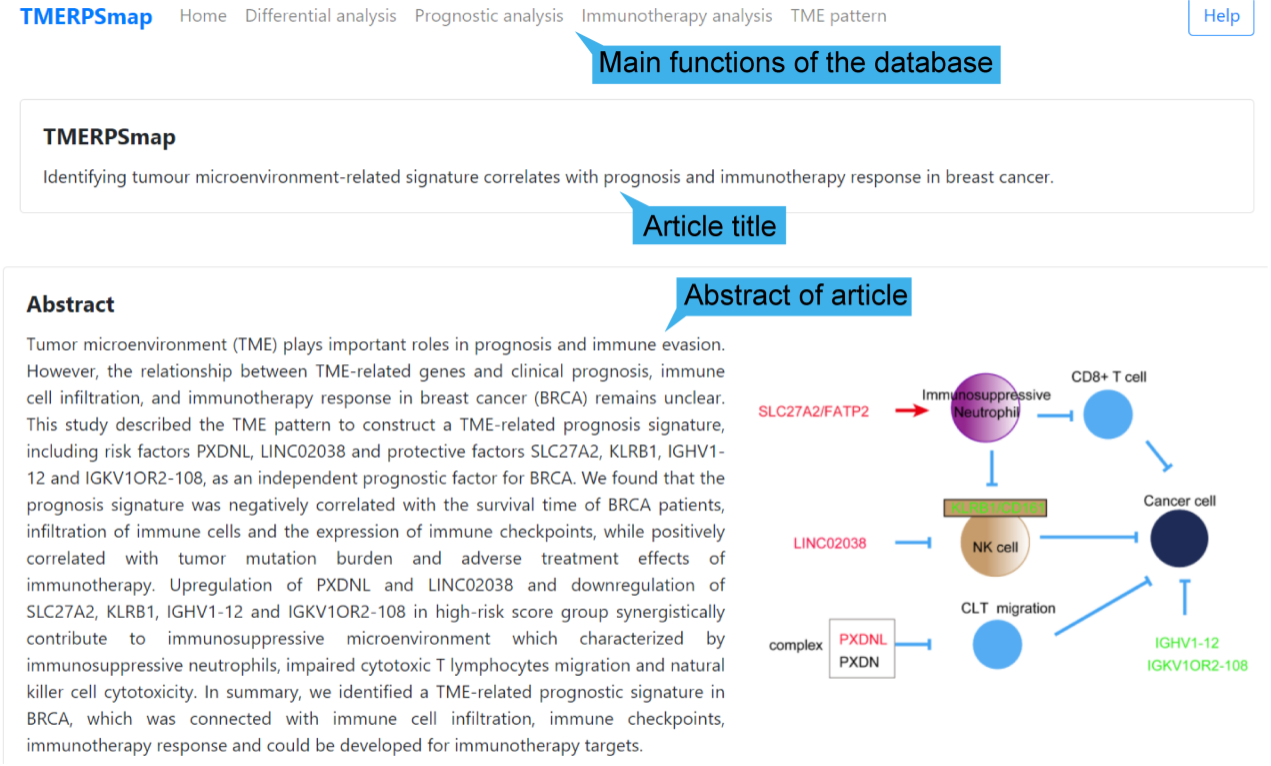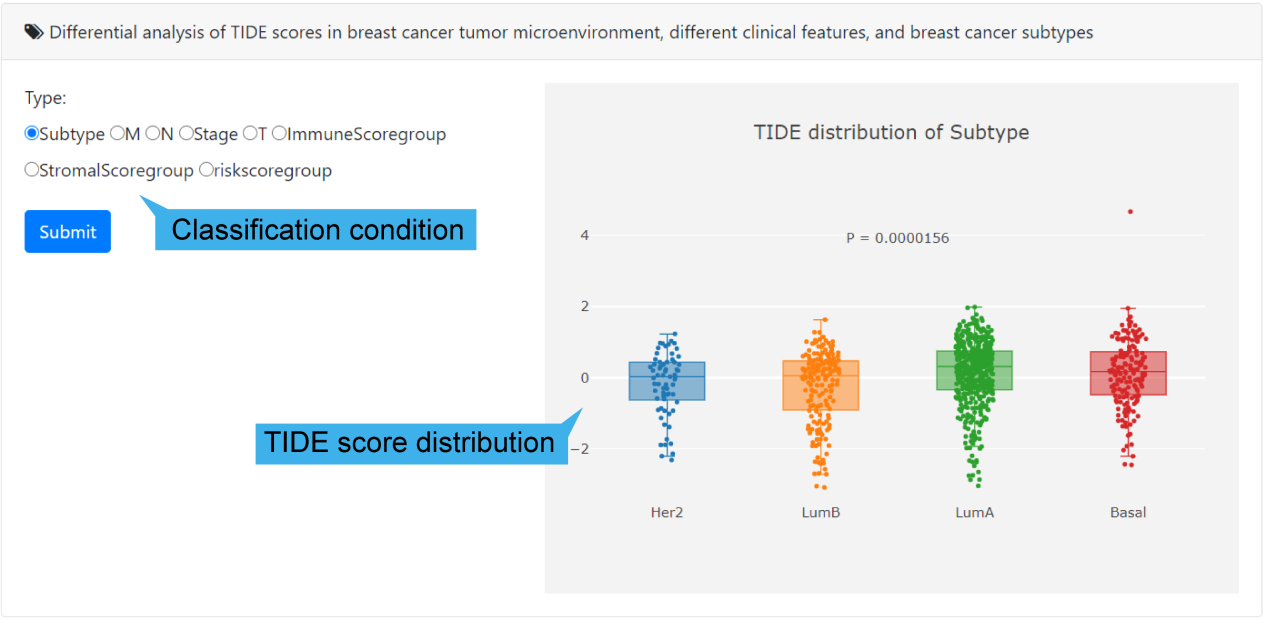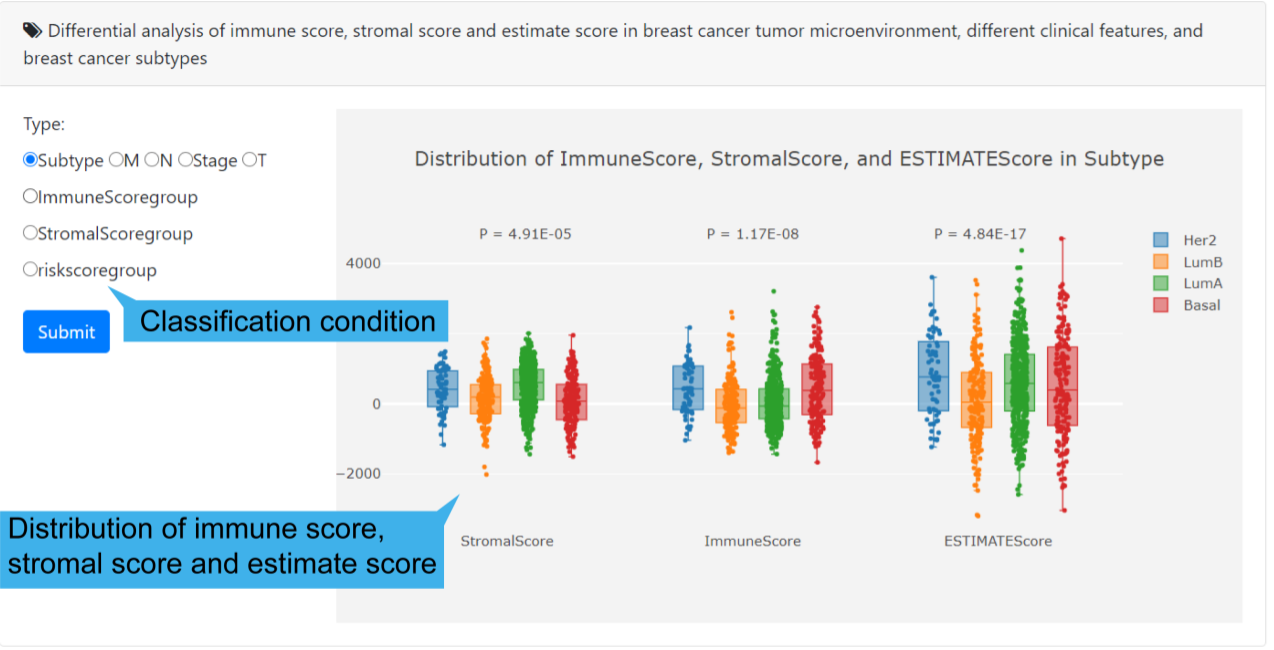Help Tutorial
The analytical content of the article "Identifying tumour
microenvironment-related signature correlates with prognosis and immunotherapy response
in breast cancer".


Expression dysregulation of TME-related genes in different clinical
features, breast cancer tumor microenvironment and breast cancer subtypes. We identified
509 up-regulated genes and 1954 down-regulated genes based on immune scores. Similarly,
based on stromal scores, 1235 up-regulated genes and 2135 down-regulated genes were
obtained. A total of 786 common DEGs in both stromal and immune groups, consisting of
258 upregulated genes and 528 downregulated genes were regarded as TME-related
genes.

Subtype: The four subtypes of breast cancer, including Basal, Her2, LumA and LumB.
M: The clinical features of breast cancer represent distant metastases, including M0 and M1.
N: The clinical features of breast cancer represent domain lymph node involvement, including N0, N1, N2 and N3.
T: The clinical features of breast cancer represent the presence of the primary tumor, including T1, T2, T3 and T4.
Stage: The clinical features of breast cancer represent a comprehensive tumor stage, including Stage I, Stage II, Stage III and Stage IV.
ImmuneScoregroup: Breast cancer samples were divided into high and low groups based on median immune scores.
StromalScoregroup: Breast cancer samples were divided into high and low groups based on median stromal scores.
Riskscoregroup: Breast cancer samples were divided into high and low groups based on median risk scores.

Subtype: The four subtypes of breast cancer, including Basal, Her2, LumA and LumB.
M: The clinical features of breast cancer represent distant metastases, including M0 and M1.
N: The clinical features of breast cancer represent domain lymph node involvement, including N0, N1, N2 and N3.
T: The clinical features of breast cancer represent the presence of the primary tumor, including T1, T2, T3 and T4.
Stage: The clinical features of breast cancer represent a comprehensive tumor stage, including Stage I, Stage II, Stage III and Stage IV.
ImmuneScoregroup: Breast cancer samples were divided into high and low groups based on median immune scores.
StromalScoregroup: Breast cancer samples were divided into high and low groups based on median stromal scores.
Riskscoregroup: Breast cancer samples were divided into high and low groups based on median risk scores.
Relationship between TME-related genes and prognosis in patients with
breast cancer. Through univariate Cox regression analysis, 168 TME-related genes were
identified as important factors affecting the survival of BRCA patients. After
multivariate Cox regression analyses with clinic-pathological characteristics (age, sex,
pathological T stage, pathological N stage, pathological M stage and pathological tumor
stage), 33 of 168 TME-related genes with FDR < 0.05 were identified as candidate
genes
associated with prognosis in BRCA.


Relationship between immunotherapy effect and tumor microenvironment,
clinical features, TME-related prognosis signature, and breast cancer subtypes. A high
TIDE score was associated with a greater likelihood of immunotherapy non-responder,
while a low TIDE score was the opposite.

Subtype: The four subtypes of breast cancer, including Basal, Her2, LumA and LumB.
M: The clinical features of breast cancer represent distant metastases, including M0 and M1.
N: The clinical features of breast cancer represent domain lymph node involvement, including N0, N1, N2 and N3.
T: The clinical features of breast cancer represent the presence of the primary tumor, including T1, T2, T3 and T4.
Stage: The clinical features of breast cancer represent a comprehensive tumor stage, including Stage I, Stage II, Stage III and Stage IV.
ImmuneScoregroup: Breast cancer samples were divided into high and low groups based on median immune scores.
StromalScoregroup: Breast cancer samples were divided into high and low groups based on median stromal scores.
Riskscoregroup: Breast cancer samples were divided into high and low groups based on median risk scores.

Subtype: The four subtypes of breast cancer, including Basal, Her2, LumA and LumB.
M: The clinical features of breast cancer represent distant metastases, including M0 and M1.
N: The clinical features of breast cancer represent domain lymph node involvement, including N0, N1, N2 and N3.
T: The clinical features of breast cancer represent the presence of the primary tumor, including T1, T2, T3 and T4.
Stage: The clinical features of breast cancer represent a comprehensive tumor stage, including Stage I, Stage II, Stage III and Stage IV.
ImmuneScoregroup: Breast cancer samples were divided into high and low groups based on median immune scores.
StromalScoregroup: Breast cancer samples were divided into high and low groups based on median stromal scores.
Riskscoregroup: Breast cancer samples were divided into high and low groups based on median risk scores.
Relationship between tumor microenvironment and clinical features,
TME-related prognosis signature, and breast cancer subtypes. The stromal score and
immune score represent the infiltration levels of stromal cells and immune cells in
tumor tissue, respectively. The estimate score was the combination of stromal score and
immune score to represent the measurement of tuomr purity. A lower estimate score,
stromal score and immune score represent higher tumor purity and lower degree of
infiltration of stromal cells and immune cells in tumor tissue, respectively.

Subtype: The four subtypes of breast cancer, including Basal, Her2, LumA and LumB.
M: The clinical features of breast cancer represent distant metastases, including M0 and M1.
N: The clinical features of breast cancer represent domain lymph node involvement, including N0, N1, N2 and N3.
T: The clinical features of breast cancer represent the presence of the primary tumor, including T1, T2, T3 and T4.
Stage: The clinical features of breast cancer represent a comprehensive tumor stage, including Stage I, Stage II, Stage III and Stage IV.
ImmuneScoregroup: Breast cancer samples were divided into high and low groups based on median immune scores.
StromalScoregroup: Breast cancer samples were divided into high and low groups based on median stromal scores.
Riskscoregroup: Breast cancer samples were divided into high and low groups based on median risk scores.

Subtype: The four subtypes of breast cancer, including Basal, Her2, LumA and LumB.
M: The clinical features of breast cancer represent distant metastases, including M0 and M1.
N: The clinical features of breast cancer represent domain lymph node involvement, including N0, N1, N2 and N3.
T: The clinical features of breast cancer represent the presence of the primary tumor, including T1, T2, T3 and T4.
Stage: The clinical features of breast cancer represent a comprehensive tumor stage, including Stage I, Stage II, Stage III and Stage IV.
ImmuneScoregroup: Breast cancer samples were divided into high and low groups based on median immune scores.
StromalScoregroup: Breast cancer samples were divided into high and low groups based on median stromal scores.
Riskscoregroup: Breast cancer samples were divided into high and low groups based on median risk scores.